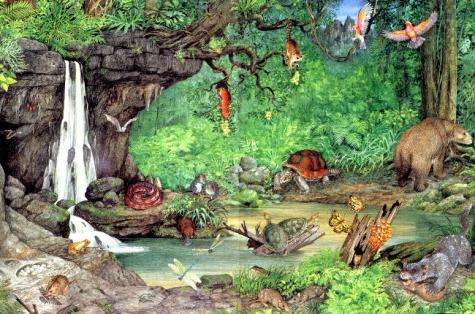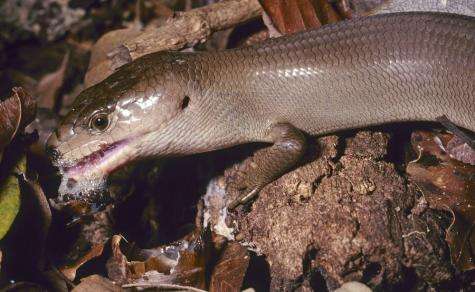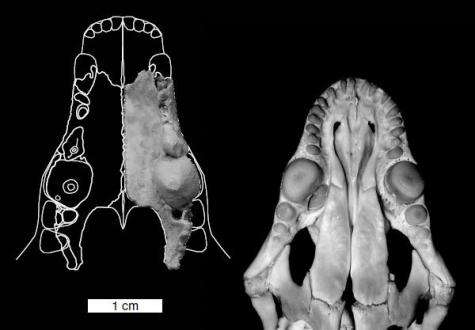Weird Australian hammer-tooth marsupial fossil found

(PhysOrg.com) -- Fossils of bizarre lizard-like, snail-eating marsupials have been discovered by UNSW palaeontologists in an ancient fossil field in the Riversleigh World Heritage area in Queensland. The fossils date back 10 to 17 million years ago.
This ferret-size mammal - now formally named Malleodectes, meaning "hammer-biter "- had an enormous blunt tooth in each side of its upper jaw, says Dr Rick Arena, lead author of the study published today in the journal Proceedings of the Royal Society B.
"At first, the function of these teeth was a mystery because we were unaware of any other mammal that had hammer-teeth like this," says Dr Arena, of the UNSW Evolution of Earth & Life Systems Research Group.
That was until co-author Dr Scott Hocknull, of the Queensland Museum, noticed the striking similarities to a modern Australian lizard, the pink-tongued skink (Cyclodomorphus gerrardii).

“This rainforest skink has an almost identical giant, hammer-tooth in its dentition and in this case we know what it’s used for: crushing the hard shells of snails, one of the main foods of this rainforest skink,” says Dr Hocknull.
"It appears Malleodectes evolved millions of years ago to exploit the ecological niche occupied today by these specialised lizards," says Dr Arena.
The researchers say the similarity between the teeth of the fossil marsupials and the living skink is a remarkable example of evolutionary convergence.
Although from very different groups of animals, these marsupials and this lizard have independently developed a similar solution to the same challenge - how to crush hard shells to be able to swallow tasty snails.
While many examples of evolutionary convergence between marsupials and placental mammals have been found on other continents – one of the most familiar being the recently extinct dog-like thylacines - this is the first time a marsupial has been found with dental adaptations most closely resembling those of a lizard.
Malleodectes eventually became extinct at some point after 10 million years ago, when the Australian continent began to respond to rapid climate change.

“It’s possible that species of Malleodectes may have survived for a bit longer in rainforest communities in eastern Australia and here found themselves in competition for snails with the similarly-specialised ancestors of the pink-tongued skinks," says Professor Mike Archer, a co-author. "If this did happen, clearly, for whatever reason, these extraordinary mammals lost out to the lizards”.
Species of this unusual animal are described in a joint paper by a team of palaeontologists from the UNSW Evolution of Earth & Life Systems Research Group and the Queensland Museum published today in the latest volume of Proceedings of the Royal Society B.
More information: rspb.royalsocietypublishing.org/
Provided by University of New South Wales



















